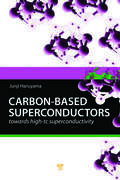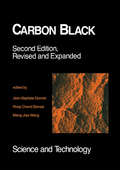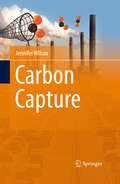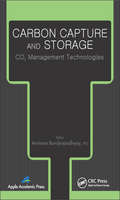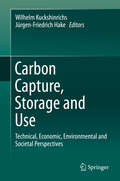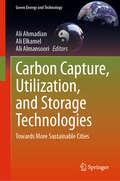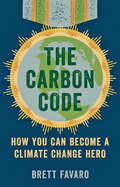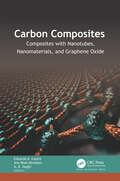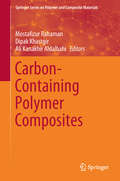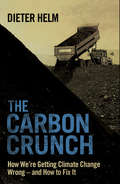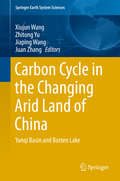- Table View
- List View
Carbon-based Solids and Materials (Iste Ser.)
by Pierre DelhaesIt is well known that solid carbons can be found in various guises with different forms of bulk phases (graphites, diamonds and carbynes) as well as more molecular forms (fullerenes,nanotubes and graphenes) resulting from recent discoveries. The cause of this rich polymorphism is analyzed in the first part of this book (chapters 1-5) with the propensity of carbon atoms for forming different types of homopolar chemical bonds associated with variable coordination numbers. Precursor organic molecules and parent compounds are also described to establish specific links with this rich polymorphism. Then in a second part (chapters 6-10) a comparative review of the main classes of bulk physical properties is presented. This approach emphasizes in particular the electronic behavior of (pi) polyaromatic systems organized in plane and curved atomic sheets. Finally in a third part (chapters 11-15) the surface and interface characteristics are introduced together with the texture and morphology of these multiscale carbon materials. An overview of the main field of applications is related showing the large use and interest for these solids.
Carbon-based Solids and Materials
by Pierre DelhaesIt is well known that solid carbons can be found in various guises with different forms of bulk phases (graphites, diamonds and carbynes) as well as more molecular forms (fullerenes,nanotubes and graphenes) resulting from recent discoveries. The cause of this rich polymorphism is analyzed in the first part of this book (chapters 1-5) with the propensity of carbon atoms for forming different types of homopolar chemical bonds associated with variable coordination numbers. Precursor organic molecules and parent compounds are also described to establish specific links with this rich polymorphism. Then in a second part (chapters 6-10) a comparative review of the main classes of bulk physical properties is presented. This approach emphasizes in particular the electronic behavior of (pi) polyaromatic systems organized in plane and curved atomic sheets. Finally in a third part (chapters 11-15) the surface and interface characteristics are introduced together with the texture and morphology of these multiscale carbon materials. An overview of the main field of applications is related showing the large use and interest for these solids.
Carbon-based Superconductors: Towards High-Tc Superconductivity
by Junji HaruyamaSuperconductors (SCs) are attractive materials in all respects for any community. They provide a deep insight into the physical properties of the condensed matters and also have useful applications as ultra-low-power-dissipation systems that can help resolve the present energy problems. In particular, the recent advancement of carbon-based new supe
Carbon Black: Science and Technology, Second Edition
by Jean-Baptiste DonnetThe second edition of this reference provides comprehensive examinations of developments in the processing and applications of carbon black, including the use of new analytical tools such as scanning tunnelling microscopy, Fourier transform infrared spectroscopy and inverse gas chromatography.;Completely rewritten and updated by numerous experts in the field to reflect the enormous growth of the field since the publication of the previous edition, Carbon Black: discusses the mechanism of carbon black formation based on recent advances such as the discovery of fullerenes; elucidates micro- and macrostructure morphology and other physical characteristics; outlines the fractal geometry of carbon black as a new approach to characterization; reviews the effect of carbon black on the electrical and thermal conductivity of filled polymers; delineates the applications of carbon black in elastomers, plastics, and zerographic toners; and surveys possible health consequences of exposure to carbon black.;With over 1200 literature citations, tables, and figures, this resource is intended for physical, polymer, surface and colloid chemists; chemical and plastics engineers; spectroscopists; materials scientists; occupational safety and health physicians; and upper-level undergraduate and graduate students in these disciplines.
Carbon Black: Science and Technology, Second Edition
by Jean-Baptiste Donnet, Roop Chand Bansal and Meng-Jiao WangThe second edition of this reference provides comprehensive examinations of developments in the processing and applications of carbon black, including the use of new analytical tools such as scanning tunnelling microscopy, Fourier transform infrared spectroscopy and inverse gas chromatography.;Completely rewritten and updated by numerous experts in the field to reflect the enormous growth of the field since the publication of the previous edition, Carbon Black: discusses the mechanism of carbon black formation based on recent advances such as the discovery of fullerenes; elucidates micro- and macrostructure morphology and other physical characteristics; outlines the fractal geometry of carbon black as a new approach to characterization; reviews the effect of carbon black on the electrical and thermal conductivity of filled polymers; delineates the applications of carbon black in elastomers, plastics, and zerographic toners; and surveys possible health consequences of exposure to carbon black.;With over 1200 literature citations, tables, and figures, this resource is intended for physical, polymer, surface and colloid chemists; chemical and plastics engineers; spectroscopists; materials scientists; occupational safety and health physicians; and upper-level undergraduate and graduate students in these disciplines.
Carbon Bonding and Structures: Advances in Physics and Chemistry (Carbon Materials: Chemistry and Physics #5)
by Mihai V. Putz"Carbon Bonding and Structures: Advances in Physics and Chemistry" features detailed reviews which describe the latest advances in the modeling and characterization of fundamental carbon based materials and recently designed carbon composites. Significant advances are reported and reviewed by globally recognized experts in the field. The quantification, indexing, and interpretation of physical and chemical patterns of carbon atoms in molecules, crystals, and nanosystems is presented. "Carbon Bonding and Structures: Advances in Physics and Chemistry" will be primarily of interest to theoretical physical chemists and computational materials scientists based in academia, government laboratories, and industry.
Carbon Capture
by Jennifer WilcoxThis book approaches the energy science sub-field carbon capture with an interdisciplinary discussion based upon fundamental chemical concepts ranging from thermodynamics, combustion, kinetics, mass transfer, material properties, and the relationship between the chemistry and process of carbon capture technologies. Energy science itself is a broad field that spans many disciplines -- policy, mathematics, physical chemistry, chemical engineering, geology, materials science and mineralogy -- and the author has selected the material, as well as end-of-chapter problems and policy discussions, that provide the necessary tools to interested students.
Carbon Capture and Storage: CO2 Management Technologies
by Amitava BandyopadhyayThis title includes a number of Open Access chapters.Carbon capture and storage (CCS) refers to a set of technologies and methods for the mitigation, remediation, and storage of industrial CO2 emissions, the most imminent and virile of the greenhouse gases (GHG). The book addresses the methods and technologies currently being applied, developed, an
Carbon Capture, Storage and Use: Technical, Economic, Environmental and Societal Perspectives
by Wilhelm Kuckshinrichs Jürgen-Friedrich HakeCarbon Capture and Storage technologies (CCS) are moving from experiment toward commercial applications at a rapid pace, driven by urgent demand for carbon mitigation strategies. This book examines the potential role of CCS from four perspectives: technology development, economic competitiveness, environmental and safety impacts, and social acceptance. IEK-STE of Forschungszentrum Juelich presents this interdisciplinary study on CCS, based on methods of Integrated Technology Assessment. Following an introductory chapter by editor Wilhelm Kuckshinrichs, Part I of the book surveys the status of carbon capture technologies, and assesses the potential for research and development of applications that are useful at scales required for meaningful mitigation. Transportation, Utilization and Environmental Aspects of CO2 receive chapter-length treatments, and the section concludes with an examination of safe geological storage of CO2 based on the example of the Ketzin pilot site, not far from Berlin. Part II covers Economic and Societal Perspectives. The first chapter discusses the use of CCS in the energy sector, analyzing costs associated with electricity generation and CO2 mitigation on the basis of technology-specific cost and process parameters, along with a merit-order illustration of the possible implications of CCS facilities for energy costs. Later chapters outline the costs of CCS application in energy- and CO2-intensive industries; analyze system characteristics of CCS infrastructures, showing that the infrastructure cost function depends on the ratio of fixed to variable costs, as well as on the spatial distribution of CO2 sources and storage facilities; interpret cross-sector carbon mitigation strategies and their impacts on the energy and CO2 balance; and discuss awareness and knowledge of CCS, attitudes towards it, and how the risks and benefits of CCS are perceived. Part III discusses the Framework for Energy and Climate Policy, with chapters on acceptance and adoption of CCS policy in Germany, and the EU, and an assessment of international cooperation in support of CCS. The final chapter summarizes the central arguments, discusses the potential role of carbon capture and utilization as part of a German transformation strategy, and extrapolates the findings to European and international contexts.
Carbon Capture, Utilization, and Storage Technologies: Towards More Sustainable Cities (Green Energy and Technology)
by Ali Ahmadian Ali Elkamel Ali AlmansooriThis book brings together cross-disciplinary research on carbon capture, utilization, and storage (CCUS) to examine the impact of implementing CCUS tools and technologies on emissions reduction and sustainable development in cities and large metropolitan areas. An expert group of global contributors provides in-depth technical discussions, case studies, and examples with an emphasis on the worldwide application of the latest developments in technology, protocols, implementation, and application of CCUS in power and energy systems.Carbon Capture, Utilization, and Storage Technologies: Towards More Sustainable Cities is an essential multidisciplinary reference for researchers and industry practitioners from engineering, energy, computer science, data science, economics, and operational research working in the energy and environmental fields.
Carbon-Centered Free Radicals and Radical Cations: Structure, Reactivity, and Dynamics (Wiley Series of Reactive Intermediates in Chemistry and Biology #2)
by Malcolm D. ForbesCovers the most advanced computational and experimental methods for studying carbon-centered radical intermediates With its focus on the chemistry of carbon-centered radicals and radical cations, this book helps readers fully exploit the synthetic utility of these intermediates in order to prepare fine chemicals and pharmaceutical products. Moreover, it helps readers better understand their role in complex atmospheric reactions and biological systems. Thoroughly up to date, the book highlights the most advanced computational and experimental methods available for studying and using these critically important intermediates. Carbon-Centered Free Radicals and Radical Cations begins with a short history of the field of free radical chemistry, and then covers: A discussion of the relevant theory Mechanistic chemistry, with an emphasis on synthetic utility Molecular structure and mechanism, focusing on computational methods Spectroscopic investigations of radical structure and kinetics, including demonstrations of spin chemistry techniques such as CIDNP and magnetic field effects Free radical chemistry in macromolecules Each chapter, written by one or more leading experts, explains difficult concepts clearly and concisely, with references to facilitate further investigation of individual topics. The authors were selected in order to provide insight into a broad range of topics, including small molecule synthesis, polymer degradation, computational chemistry as well as highly detailed experimental work in the solid, liquid, and gaseous states. This volume is essential for students or researchers interested in building their understanding of the role of carbon-centered radical intermediates in complex systems and how they may be used to develop a broad range of useful products.
The Carbon Code: How You Can Become a Climate Change Hero
by Brett FavaroOur world is getting hotter, and it’s our fault. Our addiction to fossil fuels is destroying not only our ancient planet, but our modern civilization. How can we protect our fragile ecosystems while preserving our way of life? How can we respond to climate change deniers who mock the fact that environmental activists use fossil fuels? In short, how can your average concerned citizen live a normal life in a carbon-based economy without being justifiably called a hypocrite? In The Carbon Code, conservation biologist Brett Favaro answers these thorny questions, offering simple strategies to help you reduce your carbon footprintâ€�without abandoning common sense.Favaro’s Carbon Code of Conduct is based on the four Rs: Reduce, Replace, Refine, and Rehabilitate. After outlining the scientific basics of climate change and explaining the logic of the code he prescribes, the author describes carbon-friendly technologies and behaviors we can adopt in our daily lives. However, he acknowledges that individual action, while vital, is insufficient. To achieve global sustainability, he insists that we must make the fight against climate change "go viral" through conspicuous conservation.The Carbon Code is a tool of empowerment. People don’t need to be climate change experts to be part of the solution! In this book, Brett Favaro shows you how to take ownership of your carbon footprint and adopt a lifestyle of conspicuous conservation that will spur governments and corporations to do the same. Climate-friendly action is the best decision on every dimensionâ€�economics, health and well-being, and social justice. Saving the planet is, after all, about saving ourselves. The Carbon Code provides a framework to do this, and helps you to become a hero in the fight against climate change.
The Carbon Code: How You Can Become a Climate Change Hero
by Brett FavaroOur world is getting hotter, and it’s our fault. Our addiction to fossil fuels is destroying not only our ancient planet, but our modern civilization. How can we protect our fragile ecosystems while preserving our way of life? How can we respond to climate change deniers who mock the fact that environmental activists use fossil fuels? In short, how can your average concerned citizen live a normal life in a carbon-based economy without being justifiably called a hypocrite? In The Carbon Code, conservation biologist Brett Favaro answers these thorny questions, offering simple strategies to help you reduce your carbon footprintâ€�without abandoning common sense.Favaro’s Carbon Code of Conduct is based on the four Rs: Reduce, Replace, Refine, and Rehabilitate. After outlining the scientific basics of climate change and explaining the logic of the code he prescribes, the author describes carbon-friendly technologies and behaviors we can adopt in our daily lives. However, he acknowledges that individual action, while vital, is insufficient. To achieve global sustainability, he insists that we must make the fight against climate change "go viral" through conspicuous conservation.The Carbon Code is a tool of empowerment. People don’t need to be climate change experts to be part of the solution! In this book, Brett Favaro shows you how to take ownership of your carbon footprint and adopt a lifestyle of conspicuous conservation that will spur governments and corporations to do the same. Climate-friendly action is the best decision on every dimensionâ€�economics, health and well-being, and social justice. Saving the planet is, after all, about saving ourselves. The Carbon Code provides a framework to do this, and helps you to become a hero in the fight against climate change.
Carbon Composite Catalysts: Preparation, Structural And Morphological Property And Applications (Composites Science And Technology Ser.)
by Mohammad Jawaid Anish KhanCarbon Composites: Composites with Nanotubes, Nanomaterials, and Graphene Oxide
by Eduardo A. Castro Ann Rose Abraham A. K. HaghiThis volume demonstrates the unique place in nanotechnology and nanoscience that carbon nanomaterials occupy owing to their exceptional chemical, mechanical, thermal, and electrical properties. Carbon nanomaterials have diverse applications in super strong composite materials, smart sensors, energy storage and conversion, super-capacitors, and more. Focusing on materials rather than mechanics, this volume discusses the key roles of materials science and engineering in the development of composite materials. The result of research by many highly qualified experts in the field of experimental and theoretical research on graphene and its derivatives, the volume describes experimental methods for obtaining and characterizing samples of chemically modified graphene. It reviews the potential application areas and modifications of graphene-based composite materials and interprets the interesting physical effects discovered for the first time for graphene materials under consideration. This book covers the innovative methodologies and strategies adopted in carbon materials research area including: Synthesis, characterization, and functionalization of carbon nanotubes and graphene Surface modification of graphene Carbon-based nanostructured materials The use of carbon nanomaterials for energy applications Development of carbon nanotubes reinforced metal matrix composites and non-metallic composites and their myriad potential end-use applications Key challenges to the successful and widespread implementation of carbon nanotubes reinforced metal matrix composites and non-metallic composites Methods for quantification and improved control of carbon nanotubes distributions Recent research and design trends for carbon nanomaterials-based sensors for a variety of applications Advances and potential applications in environmental monitoring and healthcare The book will be useful for postgraduate students and researchers as well as for experts in industrial sectors. It will also appeal to those involved in materials science and nanotechnology.
Carbon Composites: Composites with Nanotubes, Nanomaterials, and Graphene Oxide
This volume demonstrates the unique place in nanotechnology and nanoscience that carbon nanomaterials occupy owing to their exceptional chemical, mechanical, thermal, and electrical properties. Carbon nanomaterials have diverse applications in super strong composite materials, smart sensors, energy storage and conversion, super-capacitors, and more. Focusing on materials rather than mechanics, this volume discusses the key roles of materials science and engineering in the development of composite materials. The result of research by many highly qualified experts in the field of experimental and theoretical research on graphene and its derivatives, the volume describes experimental methods for obtaining and characterizing samples of chemically modified graphene. It reviews the potential application areas and modifications of graphene-based composite materials and interprets the interesting physical effects discovered for the first time for graphene materials under consideration. This book covers the innovative methodologies and strategies adopted in carbon materials research area including: Synthesis, characterization, and functionalization of carbon nanotubes and graphene Surface modification of graphene Carbon-based nanostructured materials The use of carbon nanomaterials for energy applications Development of carbon nanotubes reinforced metal matrix composites and non-metallic composites and their myriad potential end-use applications Key challenges to the successful and widespread implementation of carbon nanotubes reinforced metal matrix composites and non-metallic composites Methods for quantification and improved control of carbon nanotubes distributions Recent research and design trends for carbon nanomaterials-based sensors for a variety of applications Advances and potential applications in environmental monitoring and healthcare The book will be useful for postgraduate students and researchers as well as for experts in industrial sectors. It will also appeal to those involved in materials science and nanotechnology.
Carbon-Containing Polymer Composites (Springer Series on Polymer and Composite Materials)
by Mostafizur Rahaman Dipak Khastgir Ali Kanakhir AldalbahiThis book discusses the methods synthesizing various carbon materials, like graphite, carbon blacks, carbon fibers, carbon nanotubes, and graphene. It also details different functionalization and modification processes used to improve the properties of these materials and composites. From a geometrical–structural point of view, it examines different properties of the composites, such as mechanical, electrical, dielectric, thermal, rheological, morphological, spectroscopic, electronic, optical, and toxic, and describes the effects of carbon types and their geometrical structure on the properties and applications of composites.
The Carbon Crunch: Revised and Updated
by Dieter HelmIn a new edition of his hard-hitting book on climate change, economist Dieter Helm looks at how and why we have failed to tackle the issue of global warming and argues for a new, pragmatic rethinking of energy policy. “An optimistically levelheaded book about actually dealing with global warming.”—Kirkus Reviews, starred review “[Dieter Helm] has turned his agile mind to one of the great problems of our age: why the world’s efforts to curb the carbon dioxide emissions behind global warming have gone so wrong, and how it can do better.”—Pilita Clark, Financial Times
The Carbon Cycle Flow Chart (tactile)
by RnibThis set of 2 facing pages showing a flow chart of the carbon cycle.
Carbon Cycle in the Changing Arid Land of China: Yanqi Basin and Bosten Lake (Springer Earth System Sciences)
by Xiujun Wang Zhitong Yu Jiaping Wang Juan ZhangThis book integrates the analyses of organic carbon and carbonate accumulation in soil and lake sediment in a typical arid region of China that has experienced significant climate and land-use changes.It demonstrates that carbonate accumulation greatly exceeds organic carbon in both soil and sediment. It also shows that intensive cropping with sound land management in the arid land not only increases soil organic carbon stock, but also enhances accumulation of soil carbonate, particularly in subsoils. Carbon accumulation in the lake sediment increased between 1950 and 2000, after which it declined, and the authors explore how human activity and climate change may have caused the changes in carbon burial in the lake sediment.This book is of interest to researchers in a number of fields such as soil science, limnology and global change, as well as to the policy-makers.
Carbon cycle (large print)
by RnibArrow diagram showing how carbon circulates via animals, fossil fuels, decomposition and combustion etc.
Carbon cycle (UEB contracted)
by RnibArrow diagram showing how carbon circulates via animals, fossil fuels, decomposition and combustion etc.
Carbon cycle (UEB uncontracted)
by RnibArrow diagram showing how carbon circulates via animals, fossil fuels, decomposition and combustion etc.
Carbon Dioxide and Organometallics (Topics in Organometallic Chemistry #53)
by Xiao-Bing LuThe series Topics in Organometallic Chemistry presents critical overviews of research results in organometallic chemistry. As our understanding of organometallic structure, properties and mechanisms increases, new ways are opened for the design of organometallic compounds and reactions tailored to the needs of such diverse areas as organic synthesis, medical research, biology and materials science. Thus the scope of coverage includes a broad range of topics of pure and applied organometallic chemistry, where new breakthroughs are being achieved that are of significance to a larger scientific audience. The individual volumes of Topics in Organometallic Chemistry are thematic. Review articles are generally invited by the volume editors. All chapters from Topics in Organometallic Chemistry are published OnlineFirst with an individual DOI. In references, Topics in Organometallic Chemistry is abbreviated as Top Organomet Chem and cited as a journal
Carbon Dioxide as a Source of Carbon: Biochemical and Chemical Uses (Nato Science Series C: #206)
by M. Aresta G. FortiProceedings of the NATO Advanced Study Institute, Pugnochiuso, Italy, June 22-July 3, 1986

